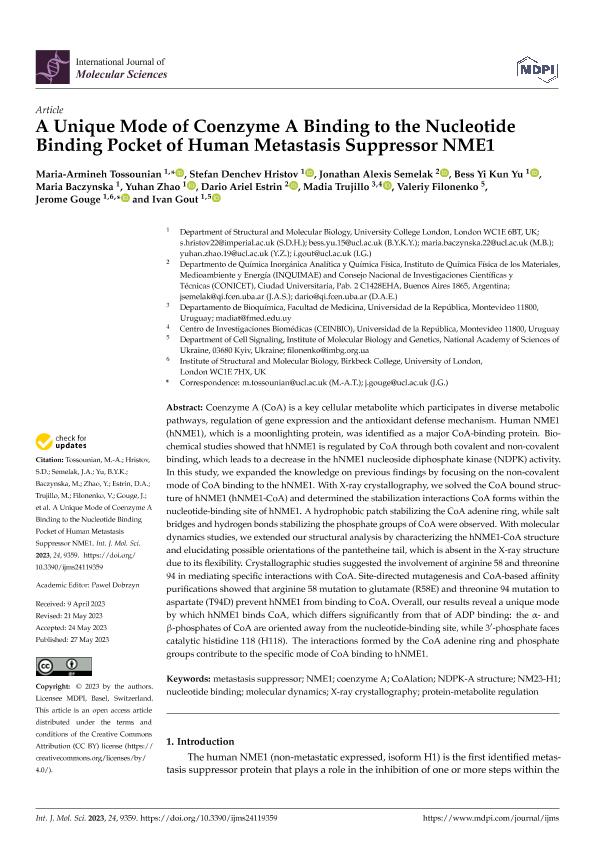Mostrar el registro sencillo del ítem
dc.contributor.author
Tossounian, Maria Armineh
dc.contributor.author
Hristov, Stefan Denchev
dc.contributor.author
Semelak, Jonathan Alexis

dc.contributor.author
Yu, Bess Yi Kun
dc.contributor.author
Baczynska, Maria
dc.contributor.author
Zhao, Yuhan
dc.contributor.author
Estrin, Dario Ariel

dc.contributor.author
Trujillo, Madia

dc.contributor.author
Filonenko, Valeriy
dc.contributor.author
Gouge, Jerome
dc.contributor.author
Gout, Ivan
dc.date.available
2024-02-27T11:24:05Z
dc.date.issued
2023-05
dc.identifier.citation
Tossounian, Maria Armineh; Hristov, Stefan Denchev; Semelak, Jonathan Alexis; Yu, Bess Yi Kun; Baczynska, Maria; et al.; A Unique Mode of Coenzyme A Binding to the Nucleotide Binding Pocket of Human Metastasis Suppressor NME1; Multidisciplinary Digital Publishing Institute; International Journal of Molecular Sciences; 24; 11; 5-2023; 1-17
dc.identifier.issn
1422-0067
dc.identifier.uri
http://hdl.handle.net/11336/228510
dc.description.abstract
Coenzyme A (CoA) is a key cellular metabolite which participates in diverse metabolic pathways, regulation of gene expression and the antioxidant defense mechanism. Human NME1 (hNME1), which is a moonlighting protein, was identified as a major CoA-binding protein. Biochemical studies showed that hNME1 is regulated by CoA through both covalent and non-covalent binding, which leads to a decrease in the hNME1 nucleoside diphosphate kinase (NDPK) activity. In this study, we expanded the knowledge on previous findings by focusing on the non-covalent mode of CoA binding to the hNME1. With X-ray crystallography, we solved the CoA bound structure of hNME1 (hNME1-CoA) and determined the stabilization interactions CoA forms within the nucleotide-binding site of hNME1. A hydrophobic patch stabilizing the CoA adenine ring, while salt bridges and hydrogen bonds stabilizing the phosphate groups of CoA were observed. With molecular dynamics studies, we extended our structural analysis by characterizing the hNME1-CoA structure and elucidating possible orientations of the pantetheine tail, which is absent in the X-ray structure due to its flexibility. Crystallographic studies suggested the involvement of arginine 58 and threonine 94 in mediating specific interactions with CoA. Site-directed mutagenesis and CoA-based affinity purifications showed that arginine 58 mutation to glutamate (R58E) and threonine 94 mutation to aspartate (T94D) prevent hNME1 from binding to CoA. Overall, our results reveal a unique mode by which hNME1 binds CoA, which differs significantly from that of ADP binding: the α- and β-phosphates of CoA are oriented away from the nucleotide-binding site, while 3′-phosphate faces catalytic histidine 118 (H118). The interactions formed by the CoA adenine ring and phosphate groups contribute to the specific mode of CoA binding to hNME1.
dc.format
application/pdf
dc.language.iso
eng
dc.publisher
Multidisciplinary Digital Publishing Institute
dc.rights
info:eu-repo/semantics/openAccess
dc.rights.uri
https://creativecommons.org/licenses/by-nc-sa/2.5/ar/
dc.subject
COALATION
dc.subject
COENZYME A
dc.subject
METASTASIS SUPPRESSOR
dc.subject
MOLECULAR DYNAMICS
dc.subject
NDPK-A STRUCTURE
dc.subject
NM23-H1
dc.subject
NME1
dc.subject
NUCLEOTIDE BINDING
dc.subject
PROTEIN-METABOLITE REGULATION
dc.subject
X-RAY CRYSTALLOGRAPHY
dc.subject.classification
Otras Ciencias Químicas

dc.subject.classification
Ciencias Químicas

dc.subject.classification
CIENCIAS NATURALES Y EXACTAS

dc.title
A Unique Mode of Coenzyme A Binding to the Nucleotide Binding Pocket of Human Metastasis Suppressor NME1
dc.type
info:eu-repo/semantics/article
dc.type
info:ar-repo/semantics/artículo
dc.type
info:eu-repo/semantics/publishedVersion
dc.date.updated
2024-02-26T11:08:59Z
dc.journal.volume
24
dc.journal.number
11
dc.journal.pagination
1-17
dc.journal.pais
Suiza

dc.description.fil
Fil: Tossounian, Maria Armineh. Colegio Universitario de Londres; Reino Unido
dc.description.fil
Fil: Hristov, Stefan Denchev. Colegio Universitario de Londres; Reino Unido
dc.description.fil
Fil: Semelak, Jonathan Alexis. Consejo Nacional de Investigaciones Científicas y Técnicas. Oficina de Coordinación Administrativa Ciudad Universitaria. Instituto de Química, Física de los Materiales, Medioambiente y Energía. Universidad de Buenos Aires. Facultad de Ciencias Exactas y Naturales. Instituto de Química, Física de los Materiales, Medioambiente y Energía; Argentina
dc.description.fil
Fil: Yu, Bess Yi Kun. Colegio Universitario de Londres; Reino Unido
dc.description.fil
Fil: Baczynska, Maria. Colegio Universitario de Londres; Reino Unido
dc.description.fil
Fil: Zhao, Yuhan. Colegio Universitario de Londres; Reino Unido
dc.description.fil
Fil: Estrin, Dario Ariel. Consejo Nacional de Investigaciones Científicas y Técnicas. Oficina de Coordinación Administrativa Ciudad Universitaria. Instituto de Química, Física de los Materiales, Medioambiente y Energía. Universidad de Buenos Aires. Facultad de Ciencias Exactas y Naturales. Instituto de Química, Física de los Materiales, Medioambiente y Energía; Argentina
dc.description.fil
Fil: Trujillo, Madia. Universidad de la República; Uruguay
dc.description.fil
Fil: Filonenko, Valeriy. Colegio Universitario de Londres; Reino Unido
dc.description.fil
Fil: Gouge, Jerome. Colegio Universitario de Londres; Reino Unido
dc.description.fil
Fil: Gout, Ivan. Colegio Universitario de Londres; Reino Unido
dc.journal.title
International Journal of Molecular Sciences

dc.relation.alternativeid
info:eu-repo/semantics/altIdentifier/url/https://www.mdpi.com/1422-0067/24/11/9359
dc.relation.alternativeid
info:eu-repo/semantics/altIdentifier/doi/http://dx.doi.org/10.3390/ijms24119359
Archivos asociados
